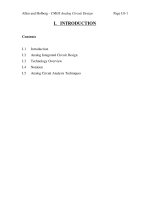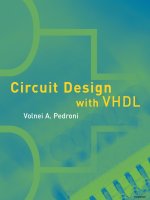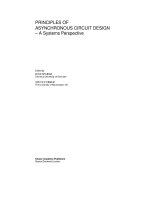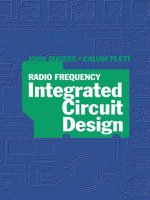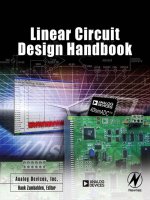Analog CMOS integrated circuit design
Bạn đang xem bản rút gọn của tài liệu. Xem và tải ngay bản đầy đủ của tài liệu tại đây (651.36 KB, 78 trang )
ANALOG CMOS INTEGRATED CIRCUIT
DESIGN
Luo Zhenying
NATIONAL UNIVERSITY OF SINGAPORE
2003
ANALOG CMOS INTEGRATED CIRCUIT
DESIGN
Luo Zhenying
(B.Sci., University of Science and Technology of China)
A THESIS SUBMITTED
FOR THE DEGREE OF MASTER OF ENGINEERING
DEPARTMENT OF ELECTRICAL AND COMPUTER
ENGINEERING
NATIONAL UNIVERSITY OF SINGAPORE
2003
ACKNOWLEDGEMENT
I would like to express my gratitude to all those who have given me support and help in
the past two years.
First and foremost, I am sincerely grateful to my supervisor Professor Li Ming Fu, for his
consistent advice, encouragement and understanding throughout the period of my research.
His patience and kindness have made working with him a pleasurable experience.
I would also like to express my utmost gratitude to my co-supervisor, Dr Subhash
Chander Rustagi from IME (Institute of Micro-Electronics of Singapore), for his genuine
concern and help in the area of device modeling of my RFIC design parts.
My appreciation also goes to my friends in Signal Processing and VLSI Design Lab, who
have helped me through out my research work in many ways.
I also want to thank my families especially my wife Yang Jing. Because of their spiritual
support, I have been able to complete this research work. They have given me the greatest
courage to overcome all the difficulties.
I
TABLE OF CONTENTS
ACKNOWLEDGEMENT .............................................................................................I
TABLE OF CONTENTS.............................................................................................II
SUMMARY ..................................................................................................................V
LIST OF FIGURE .....................................................................................................VII
LIST OF TABLE ......................................................................................................VIII
1. PROJECT I: VHF CMOS TRANSCONDUCTOR DESIGN 0[2] .....................1
1.1.
Motivations ......................................................................................................................................................... 1
1.2.
Some Transconductor design –A brief review.......................................................................................... 2
1.2.1.
Nauta’
s VHF transconductor design [5] .................................................................................................3
1.2.2.
Szczepanski’
s OTA Design [6].................................................................................................................4
1.3.
Transconductor design.................................................................................................................................... 5
1.3.1.
Introduction.................................................................................................................................................5
1.3.2.
DC Analysis of the Transconductor.........................................................................................................6
1.3.3.
Small Signal AC Analysis of the Transconductor...............................................................................13
1.3.4.
Output Common Mode DC Level Stability .........................................................................................17
1.3.5.
SpectreS Simulation Results...................................................................................................................18
1.3.6.
Gm-C Filter Application..........................................................................................................................21
1.3.7.
Conclusion.................................................................................................................................................22
2. PROJECT II: CMOS FULLY INTEGRATED LNA DESIGN [3] ................... 24
2.1.
Introduction......................................................................................................................................................24
II
2.2.
LNA Design.......................................................................................................................................................25
2.2.1.
Introduction:..............................................................................................................................................25
2.2.2.
Noise Figure Optimization: ....................................................................................................................26
2.2.3.
Input matching:.........................................................................................................................................29
2.2.4.
Linearity consideration:...........................................................................................................................30
2.2.5.
Output matching:......................................................................................................................................30
2.3.
Experimental Result: .....................................................................................................................................34
2.4.
Measurement experience:.............................................................................................................................35
2.5.
Conclusion ........................................................................................................................................................36
PUBLICATIONS....................................................................................................... 40
REFERENCE............................................................................................................ 41
APPENDICES........................................................................................................... 43
A.
Calculation of the coefficients A and B of Iout in (1.22).............................................................................43
B.
Detail expression of a ij and b ij in (1.32) and (1.33)...................................................................................43
C.
LNA input stage NF & Fixed PD NF optimization: ....................................................................................45
Calculation of the noise from Rg : .............................................................................................................................45
Calculation of the relationship between iodn and idn : .............................................................................................47
Calculation of the relationship between iogn and ign : .............................................................................................48
Calculation of combined effect of drain noise and gate noise to the output noise current: (a) correlated
and (b) uncorrelated portion......................................................................................................................................49
Correlated portion:......................................................................................................................................................51
Uncorrelated portion:..................................................................................................................................................52
Total contribution from ign and idn to ion,ign,i dn..........................................................................................................52
Noise Factor of the input stage of the LNA:..........................................................................................................52
III
Terms definition for fixed power consumption (PD ) optimization: ....................................................................54
Fixed Power Noise Figure vs. W of M1:.................................................................................................................57
D.
Impedance of the LNA input stage:................................................................................................................58
Zin of the LNA input stage:........................................................................................................................................58
Parameter values used in estimation around 2.4GHz: ..........................................................................................59
Magnitude estimation 1:.............................................................................................................................................59
Magnitude estimation 2:.............................................................................................................................................60
Magnitude estimation 3:.............................................................................................................................................61
E.
The effect of Ld1 on the output resistance of M2 (before Ld2 , CL and Co are added into the LNA):61
Ld1 introduces resistor R_:.........................................................................................................................................61
Output resistance of M2:............................................................................................................................................62
F.
List of parameter values:...................................................................................................................................62
G.
Cascaded Stage Linearity: ................................................................................................................................63
IIP3 Definition:............................................................................................................................................................63
General Cascaded Stages:..........................................................................................................................................63
Normal RF System Cascaded Stages:......................................................................................................................64
H.
Cascaded Stage Noise:........................................................................................................................................66
IV
SUMMARY
This thesis is divided into two parts according to the two projects I was involved in during
the past two years: VHF CMOS Transconductor design and CMOS LNA design.
In the first part, a novel IC structure realizing a low voltage CMOS VHF transconductor is
proposed. This is a totally new design with some important features such as the high
linearity I-V conversion and high common mode rejection ratio (CMRR). The advantage
of the proposed transconductor is the simple circuit structure, which makes it suitable for
very high frequency applications. The drawbacks of the proposed transconductor design
are: there is no gm tuning method except to changing the power supply voltage, which also
implies that the transconductor has a poor power supply rejection ratio (PSRR); limited
input signal range due to the cascade structure.
The second part of this thesis presents the detailed procedures of a CMOS fully integrated
LNA design with the input and output matching network. Although the structure of a LNA
contains only a small number of components in total, however, the choosing of each
“proper”component contains lots of trade-offs. The performance of the LNA is sensitive
to some of its components especially those in its output stage. Only a little incaution will
cause oscillation or even result in the LNA failing to work. I have written down all my
experiences of success and failure here to remind myself not to make the same mistake
again.
In order to simplify the delivery of the main idea and let readers easily grasp the main
V
stem of the design procedure, only results are given in these two parts of the thesis.
Readers can refer to the appendices for the detailed derivations procedures.
VI
LIST OF TABLES
Table 1 Common and differential load resistances seen on nodes Vo1 and Vo2 ,
Realized by the transconductances gm3- gm6 of Inv3-Inv6. ............................... 4
Table 2 Specification of the transconductor. .............................................................. 21
Table 3 LNA performance summary. ......................................................................... 37
Table 4 Component parameters of the proposed LNA .............................................. 37
Table 5 Parameter values. .......................................................................................... 63
VII
LIST OF FIGURES
Fig 1 Nauta’
s VHF Transconductor. ............................................................................ 3
Fig 2 Simplified scheme of the proposed CMOS OTA with a voltage-variable NRL
circuit ................................................................................................................... 4
Fig 3 Complete circuit diagram of the CMOS OTA with the NRL. ............................ 5
Fig 4 The proposed transconductor circuit. ................................................................. 6
Fig 5 A in (1.22) is almost constant versus Vcm for Vcm from 1.2V to 1.5V. B in
(1.22) is much smaller than A (less than 0.1) in this Vcm range. Vcm- ground=
(1.2+1.5)/2=1.35V is designated as “common mode ground voltage”.............. 10
Fig 6 I1, I2 and Iout = 2(I1-I2) versus Vid (Vcm =Vcm- ground). ........................... 10
Fig 7 Simulation result of the proposed transconductor using 0.35µm BSIM3v3
model.................................................................................................................. 12
Fig 8 nMOS and pMOS transistors small signal equivalent circuits. ........................ 14
Fig 9 Small signal equivalent circuit of the proposed transconductor cell. ............... 14
Fig 10 Bode plot of Iout versus frequency using (1.43). It exhibits only one pole and
two zeros in the whole frequency range............................................................. 17
Fig 11 A complete schematic of the proposed transconductor. W/L (M1, M1”, M5,
M5”, M3, M6, N1, N1”, N3) = 34.7µm/0.3µm; W/L (M2, M4, M7, M8, M11,
M12, M4”, M8”, N2, N4, N10, N8”) = 10µm/0.3µm........................................ 18
Fig 12 SpectreS simulation of Iout, versus Vid of the transconductor. The gm can be
tuned by changing the power supply. ................................................................. 19
Fig 13 Frequency response of the gm-Cell. ............................................................... 19
Fig 14 Change of THD of the transconductor circuit, when channel width of pMOSs
(Wp) in the gm-Cell is changing while the channel width of nMOS (Wn) is a
constant of 10µm, which represents the mismatch of parameters during process.20
Fig 15 3rd order elliptic low pass filter using the proposed transconductor.
gm=750µA/V, C1=C3=6.56pF, C2=400fF, C=1.38pF. ...................................... 21
Fig 16 3rd order elliptic low-pass LC ladder filter. ................................................... 22
VIII
Fig 17 Simulation result of the filter. A cutoff frequency of 150MHz is obtained. ... 22
Fig 18 RF section of a cell phone. ............................................................................. 24
Fig 19 LNA Diagram. ................................................................................................ 26
Fig 20 Simplified input structure. .............................................................................. 27
Fig 21 NF vs. W. ........................................................................................................ 28
Fig 22 LNA input stage. ............................................................................................. 29
Fig 23 Analysis of the output resistance. ................................................................... 31
Fig 24 Simulation result of Ro vs. Freq. .................................................................... 31
Fig 25 M2 & Ld1. ...................................................................................................... 32
Fig 26 Ro vs. Freq...................................................................................................... 32
Fig 27 Ld2 selection. .................................................................................................. 34
Fig 28 LNA micrograph. ............................................................................................ 34
Fig 29 S-parameters of the LNA. ............................................................................... 38
Fig 30 Noise Figure. .................................................................................................. 39
Fig 31 Two tone test. .................................................................................................. 39
Fig 32 Simplification of the input matching structure. .............................................. 45
Fig 33 Illustration of drain current noise contribution of M1. ................................... 47
Fig 34 Illustration of gate current noise contribution of M1. .................................... 48
Fig 35 Fixed power Noise Figure Vs Channel width of M1. ..................................... 58
Fig 36 Small signal equivalent circuit of the LNA input stage. ................................. 58
Fig 37 Simplified equivalent circuit of M2 in LNA output stage. ............................. 61
Fig 38 Cascaded nonlinear stages. ............................................................................. 64
IX
1. PROJECT I: VHF CMOS Transconductor DESIGN
0[2]
1.1. Motivations
All modern communication systems, such as radio, TV, telephony and most
instrumentation systems contain various types of electrical filters. Over the last decade
active monolithic filters have become increasingly important for many signal processing
applications. Monolithically integrated, filters have several advantages over active filters
built with discrete components. These advantages are: good matching of components on
chip, automatic tuning can correct the transfer function for process and temperature
variations, reduced parasitic capacitances on chip, and last but not least: low-cost if these
filters are fabricated in large numbers. In the design of monolithic analog filters at very
high frequencies, high-speed, fully-balanced transconductance amplifier has received
considerable attention as convenient active elements and the transconductance-capacitor
(Gm-C) approach is used most often. This technique is well-known for implementing
high-speed continuous time filters and is widely used in many industrial applications [4]
The core work of a Gm-C filter design is to design an OTA as ideally as possible with the
following features:
An infinite input and output impedance;
An infinite frequency response bandwidth;
1
Large input and output linear range (Rail- to-rail);
Low voltage power supply and low power consumption;
Can be easily tuned;
Infinite CMRR (For differential input only).
Unfortunately these features are incompatible and have lots of trade-offs among them.
Designers are trying their best to mediate the conflicts and focus their effort on the
features which are more important in their application.
1.2. Some Transconductor design – A brief review
For a long time, in the field of continuous time analog filter design, people are seeking
ways to make their design achieve better performance in HF application. In the realm of
Gm-C filter design (low pass), the most critical problem is to design a transconductor that
has a very high cut-off frequency. Further more, to get a better performance of the
transconductor, a low voltage supply, linear input-output characteristic for wide range,
large output resistance, high CMRR, and a tunable transconductance should be also be
considered. In the following part of this report, these questions will be discussed and
some design schemes will be presented.
2
1.2.1. Nauta’s VHF transconductor design [5]
Fig 1 Nauta’s VHF Transconductor.
A Gm-C filter technique for very high freque ncies is proposed by Bram Nauta in 1994
that has a very attractive feature – VHF owing to its absence of internal node. The V-I
conversion expression is shown below:
I od = I o1 − Io 2 = Vid (Vdd −V th + Vtp ) β n ⋅ β p = Vid ⋅ gmd
Here βn =
µ pCoxW p
µ nCoxWn
,βp =
Ln
Lp
(1.1)
(1.2)
The four inverters (Inv3--Inv6) constituting the so call Common-Mode Control and
DC-Gain Enhancement part, which suppress the common mode signal and enhance the
differential one. The result of this enhancement scheme is summarized in Table 1
Common and differential load resistances seen on nodes Vo1 and Vo2, Realized by the
transconductors gm3-gm6 of Inv3-Inv6.
3
Output Node
Vo1
Vo 2
Common Resistance
Differential Resistance
g m5
1
+ g m6
1
− gm6
g m5
g m4
1
+ g m3
1
g m 4 − g m3
Table 1 Common and differential load resistances seen on nodes Vo1 and Vo2 , Realized by the
transconductances gm3-gm6 of Inv3 -Inv6.
1.2.2. Szczepanski’s OTA Design [6]
This is another transconductor design for VHF application proposed by Szczepanski.
Fig 2 Simplified scheme of the proposed CMOS OTA with a voltage-variable NRL circuit
Without the upper potion of NRL (Negative Resistance Load) circuit, the V-I expression
is:
I out = I1 − I 2 = 2k nVBVid
(1.3)
4
The resistance of the NRL circuit:
RN =
−1
k p (VDD − VA )
Here: K n =
µ nC ox
2
(1.4)
µ p Cox
W
,Kp =
2
L n
W
L p
(1.5)
The complete circuit diagram of the OTA with the NRL is shown below:
Fig 3 Complete circuit diagram of the CMOS OTA with the NRL.
1.3. Transconductor design
1.3.1. Introduction
CMOS transconductor is a useful building block for the design of Analog and mixed
5
signal integrated circuit systems, particularly for the design of continuous-time Gm-C
filters. Over the pass few years, a few CMOS transconductor designs have been reported
for high- frequency continuous-time signal processing applications. [5]-[8]
In this thesis, a new structure with some specific merits to realize the low voltage CMOS
VHF transconductor is proposed. The 0.35µm CMOS BSIM3v3 model is used in Cadence
simulation, DC analysis shows that the linear V-I conversion of the transconductor can be
achieved with a high common mode rejection and a large linear differential mode input
voltage range of ±0.9V. Also, the small signal frequency analysis shows that a very high
frequency bandwidth is achieved and with good agreement with the Cadence simulation.
An auxiliary circuit is added to the design to control the output DC voltage level. Finally,
the Cadence simulation results of the transconductor and a 3rd order elliptic low pass
Gm-C filter is presented.
1.3.2. DC Analysis of the Transconductor
Fig 4 The proposed transconductor circuit.
6
The transconductor circuit is shown in Fig 4. The idea is to create a circuit structure with
minimum number of internal nodes so that the circuit structure is suitable for high
frequency operation. In addition, the circuit should have a high common mode input
rejection. The circuit structure in Fig 4 is reflection symmetric about the SS’line. When
the differential mode input Vid = 0 with only the common mode input Vcm is applied, the
input does not change the circuit symmetry. If all current mirrors are ideal with unity
current reflection, it is clear from Fig 4 that the output current Iout+ = Iout- = 0. The circuit
inherently has a good common mode rejection. Actually, checking the input at transistors
M2 and M3 , when Vcm is increased, the increased current through M2 compensates the
decreased current through M3 and therefore their current summation, I1 changes little.
However, if the differential mode input Vid is increased, both currents through M2 and M3
increase and therefore their sum I1 changes significantly. On the other hand, the
differential mode input Vid destroys the symmetry of the circuit about the SS’line and
leads to the current sum I2 also changes significantly in the opposite sign of I1 . Therefore
Iout+ = - Iout- , and the output current Iout = Iout+ - Iout- is increased.
Detailed analysis shows that Iout changes almost linearly with Vid with a transconductance
coefficient almost independent of Vcm within a certain range. This is analyzed as follows
where the long channel CMOS device I-V equations for the saturation mode operation are
used [9] as a first approximation:
For nMOS transistors:
I ds = K n (V gs − Vtn ) 2
(1.6)
7
Kn =
µ nC ox W
2 L n
(1.7)
and for pMOS transistors:
I sd = K p (Vsg − Vtp ) 2
Kp =
(1.8)
µ p Cox W
2 L p
(1.9)
where Vtn and Vtp are the absolute value of the nMOS and pMOS transistor threshold
voltages respectively. Adjusting the W/L ratio of the nMOS and pMOS transistors to fit
the following relationship:
Kn = K p =
µ n , pC ox W
=K
2 L n ,p
(1.10)
or W p W n = µ n µ p
(1.11)
Re-writing (1.6) (1.8) using normalized drain current:
I i = (I sd K )i
(1.12)
For drain current of M1 , we have:
I 1 = (Vdd − V1 − Vtp )
2
(1.13)
for the sum of the drain currents of M2 and M3 , we have:
2
V
V
I 1 = Vcm + id − V2 − Vtn + V1 − Vcm + id − Vtp
2
2
2
(1.14)
8
for the drain current of M4 , we have:
I 1 = (V2 − Vss − Vtn )
2
(1.15)
Similarly for M5 , M6 , M7 and M8 , we have:
I 2 = (Vdd − V3 − Vtp )
2
(1.16)
2
V
V
I 2 = Vcm − id − V 4 − Vtn + V 3 − V cm − id − Vtp
2
2
2
(1.17)
I 2 = (V4 − V ss − Vtn )
2
(1.18)
From (1.13) to (1.18), we obtain the following result:
−2Vtp − 2Vtn − Vss + Vdd ± Vid −
I1,2 = 2 ⋅ (2Vcm ± Vid − 4Vtn − 2Vss )( −2Vcm ± Vid − 4Vtp + 2Vdd )
2
2
(1.19)
Each current mirror in Fig 4 has a pair of identical transistors. We can easily obtain:
I out+ = − I out− = I 1 − I 2
and:
(1.20)
I out = I out+ − I out− = 2( I 1 − I 2 )
(1.21)
giving 0.35µm CMOS technology typical values to Vtn and Vtp and substituting Vdd = 3V ,
Vss = 0V into (1.19) (1.20), we obtain the following Taylor expansion of Iout:
I out = A ⋅ Vid + B ⋅ Vid + O(Vid )
3
5
(1.22)
9
A
B
Fig 5 A in (1.22) is almost constant versus Vcm for Vcm from 1.2V to 1.5V. B in (1.22) is much
smaller than A (less than 0.1) in this Vcm range. Vcm-ground= (1.2+1.5)/2=1.35V is designated as
“common mode ground voltage”.
Iout = 2(I1 −I2 )
I1
I2
Fig 6 I1, I2 and Iout = 2(I1-I2) versus Vid (Vcm =Vcm-ground).
Both A and B in (1.22) are functions of Vcm as plotted in Fig 5 The analytical expressions
of A and B in (1.22) can be found in the Appendix. As indicated in Fig 5, the
transconductance value A is almost a constant within the Vcm range:
1.2V < Vcm < 1.5V
(1.23)
10
and B is very close to 0 in this range. From (1.23), we designate (1.2+1.5)/2 =1.35V as the
“common mode ground voltage” Vcm-ground . In the system design, a common mode
feedback control is used to force the output common mode voltage approaching 1.35V.
In the above analysis, all MOS transistors in Fig 4 operate in the saturation region and
strong inversion. The following conditions must be satisfied by the input MOS transistors
M2 , M3 and M6 , M7 :
for M2 :
(Vss + Vtn ) + Vtn
≤ Vin+ ≤ (Vdd − Vtp ) + Vtn
∴ 0.94V ≤ Vin+ ≤ 2.85V
(1.24)
(1.25)
for M3 :
(Vss + Vtn ) − Vtp ≤ Vin− ≤ (Vdd
− Vtp ) − Vtp
∴ −0.15V ≤ Vin− ≤ 1.77V
(1.26)
(1.27)
similarly, for M6 and M7 :
− 0.15V ≤ Vin+ ≤ 1.77V , 0.94V ≤ Vin− ≤ 2.85V
(1.28)
combining (1.25)-(1.28), we obtain :
0.94V ≤ Vin± ≤ 1.77V
(1.29) is another constraint condition for the input signal. Since Vcm-ground
(1.29)
= 1.35V is
11
almost at the middle of the range defined in (1.29), when the common mode voltage is at
Vcm-ground , the differential mode input will have a maximum AC input range. Fig 6 is the
plot for (1.19)-(1.21) which shows an almost linear output current Iout versus the input
differential voltage Vid while the input common mode voltage is kept on Vcm− ground . In the
system design, a common mode feedback control is used to force the common mode
voltage Vcm approaching 1.35V.
Although the above analysis based on (1.6) (1.8) neglected the following effects: the finite
output impedance [9], body effect of input nMOS’
s [9] and short channel effects [10], the
overall specification is predicted fairly well compared with more accurate Cadence
simulation result shown in Fig 7.
Fig 7 Simulation result of the proposed transconductor using 0.35µm BSIM3v3 model
12
1.3.3. Small Signal AC Analysis of the Transconductor
In the AC analysis of the transconductor circuit, the following approximations are used:
The small signal equivalent circuits as shown in Fig 8 are used for all MOS transistors.
Using the same scaling factor to characterize the parasitic capacitances of nMOS and
pMOS transistors. Or Ci =α i W. W is the channel width (while the channel lengths of all
transistors are the same). The index i specifies Cgs, or Cgd or Cds. Therefore, according to
(1.11), Cgs (or Cgd , Cds) of pMOS transistor is µ n µ p ≈ 3 times as that of nMOS
transistor.
According to (1.6) (1.8), the transconductance of the transistor is Gm = 2 K ⋅ W ⋅ I ds L .
When the common mode input voltage is at Vcm-ground , the currents through M2 and M3
(M6 and M7 ) are nearly equal and are half of the current through M1 (or M4 ), so the Gm of
M2 and M3 (M6 and M7 ) is 1
2 times the Gm of M1 and M4 (M5 and M8 ).
For nMOS transistors and pMOS transistors, the output resistance is R = VE L I DSsat [9]
and it roughly neglects the difference of Early voltage per unit-channel length VE between
the nMOS and pMOS transistors. This approximation is very crude. However, the effect
of R in the frequency response is almost negligible as is explained in the appendix, so the
approximation is acceptable and will simplify the analytic equations.
The output voltage is clamped to a constant voltage level when simulating the V-I
response. In other word, it is grounded during the small signal analysis. Otherwise the
output node will introduce more poles or zeros depending on the load condition and cause
13
the mathematical analysis to be too complex.
D
S
Cgd
G
Cgs
Gm
Cds
R
Cgs
G
Gm
Cds
R
Cgd
NMOS
PMOS
S
D
Fig 8 nMOS and pMOS transistors small signal equivalent circuits.
Under these approximations, the small signal equivalent circuit of the gm -Cell is shown in
Fig 9
RdsM1"//RdsM8"
CdsM1+2CgsM1
RdsM1
3(Cds+2Cgs) (R)
gm1
gm1"
(Gm)
(Gm)
RdsM5"//RdsM4"
(R/2)
gm5"
gm5
CgdM5"
V1
RdsM5
CdsM5+2CgsM5
V3
CgdM1"
(3Cgd)
CgdM2
RdsM2//RdsM3
CgsM6
CgsM3
(R)
Vin_p
gm2
CdsM2+CdsM3
(Gm/1.414) (4Cds)
gm3
(Gm/1.414)
Vin_n
CgdM3
CgsM2
CgdM7
RdsM6//RdsM7
(3Cgs)
Iout+
gm6
Vin_p
Iout-
(3Cgd)
CgdM8"
(Cgd)
CdsM4"+CdsM5"
(2Cds)
RdsM4
(R)
Vin_n
V4
CgdM4"
(Cds+Cgs)
gm7
CgsM7
V2
CdsM4+2CgsM4
CdsM6+CdsM7
CgdM6
gm4
gm4"
(Gm)
(Gm)
RdsM8
gm8"
CdsM8+2CgsM8
gm8
CdsM8"+CdsM1"
Fig 9 Small signal equivalent circuit of the proposed transconductor cell.
Using Kirchoff’s Current Law (KCL):
At node V1 :
−V1 ⋅s ( Cds + 2C gs ) −
V1
Gm
− V1Gm − 3VsC
1
gd + 3 (Vin _ n −V1 ) sC gs − (V1 − Vin _ n )
R
2
V1 − V2 )
(
Gm
−
− ( V1 −V2 ) s ⋅ 4Cds − (Vin _ p − V2 )
− (V1 − Vin _ p ) sCgd = 0
R
2
(1.30)
14

